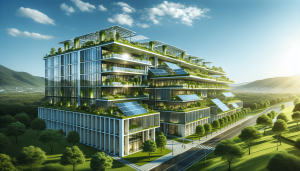Let’s explore the fascinating intersection of sustainable architecture and urban planning. As we delve into this topic, we’ll discover how the principles of eco-friendly design seamlessly mesh with the broader objectives of developing our cities. We’ll uncover the benefits of integrating green technologies, the importance of community-focused layouts, and how policy and innovation join hands to build a more sustainable future for us all. Together, we’ll see how these two disciplines collaborate to create urban spaces that not only meet our current needs but also ensure the well-being of future generations. Have you ever wondered how sustainable architecture integrates with urban planning? We live in a time where sustainable development is more crucial than ever, and understanding how different aspects of our built environment work together is essential. By combining sustainable architecture with urban planning, we can shape cities that are not only environmentally friendly but also highly functional and enjoyable places to live.

What is Sustainable Architecture?
Sustainable architecture focuses on reducing the negative environmental impact of buildings while improving their efficiency and comfort. This involves using renewable resources, reducing waste, and creating spaces that promote health and well-being.
Key Elements of Sustainable Architecture
Sustainable architecture incorporates several key elements that make buildings more eco-friendly. These include energy efficiency, water conservation, and the use of sustainable building materials.
Energy Efficiency
Energy-efficient buildings reduce the amount of energy required for heating, cooling, lighting, and other functions. This can be achieved through various means, such as improved insulation, energy-efficient windows, and the use of renewable energy sources like solar panels.
Water Conservation
Water conservation is another critical component of sustainable architecture. This can involve the use of low-flow fixtures, rainwater harvesting systems, and greywater recycling to reduce water waste and minimize the building’s overall water footprint.
Sustainable Building Materials
Using sustainable building materials means selecting resources that have a lower environmental impact. This might include materials that are recycled, rapidly renewable, or produced responsibly. Examples include bamboo, reclaimed wood, and recycled metal.
What is Urban Planning?
Urban planning involves the development and organization of the land in urban areas to create functional, attractive, and sustainable environments. This field addresses various aspects of urban life, including transportation, infrastructure, public spaces, and housing.
Important Components of Urban Planning
Effective urban planning involves multiple components that work together to create well-functioning urban environments. These components include zoning regulations, public transportation systems, green spaces, and housing policies.
Zoning Regulations
Zoning regulations govern how land in a given area can be used, determining where residential, commercial, industrial, and recreational activities can take place. These regulations help ensure that land is used in a way that promotes sustainability and meets community needs.
Public Transportation Systems
Public transportation systems are essential for reducing traffic congestion, lowering carbon emissions, and promoting accessibility. Sustainable urban planning aims to design efficient and convenient public transportation networks that connect different parts of the city.
Green Spaces
Green spaces, such as parks, gardens, and urban forests, provide numerous benefits, including improved air quality, reduced urban heat island effects, and opportunities for recreation. Incorporating green spaces into urban planning is crucial for creating healthy, sustainable cities.
Housing Policies
Housing policies play a significant role in urban planning, influencing the availability, affordability, and quality of housing. Sustainable housing policies promote the development of energy-efficient, environmentally friendly homes that meet the needs of diverse populations.
How Do Sustainable Architecture and Urban Planning Intersect?
Sustainable architecture and urban planning are closely linked, as both aim to create built environments that are environmentally, economically, and socially sustainable. By integrating these two fields, we can address various challenges and create holistic solutions for our cities.
Designing Energy-Efficient Urban Areas
One way sustainable architecture and urban planning intersect is through the design of energy-efficient urban areas. By considering the placement and orientation of buildings, urban planners can maximize natural light and ventilation, reducing the need for artificial lighting and climate control.
Building Placement and Orientation
Strategically placing buildings and orienting them to take advantage of natural light and breezes can significantly reduce energy consumption. For example, designing buildings with large south-facing windows can harness passive solar energy, providing natural warmth during the winter months.
Mixed-Use Developments
Mixed-use developments combine residential, commercial, and recreational spaces within a single area, reducing the need for long commutes and encouraging walking and biking. This not only lowers energy consumption but also fosters a sense of community.
Promoting Sustainable Transportation
Integrating sustainable architecture with urban planning can also promote sustainable transportation options, such as biking, walking, and public transit.
Bicycle and Pedestrian Infrastructure
Designing cities with dedicated bike lanes and pedestrian-friendly pathways encourages residents to choose active transportation modes, reducing reliance on cars and lowering greenhouse gas emissions. Planners can also incorporate features like bike racks and showers in buildings to make cycling more convenient.
Public Transit-Oriented Development
Public transit-oriented development focuses on creating dense, walkable communities centered around public transportation hubs. This approach makes public transit a more attractive option, reducing car usage and promoting sustainability.
Enhancing Stormwater Management
Sustainable architecture and urban planning can work together to improve stormwater management, reducing flooding and protecting water quality.
Green Roofs and Walls
Green roofs and walls are covered with vegetation, which helps absorb rainwater, reduce runoff, and provide insulation. By incorporating these features into building designs, architects can contribute to more effective stormwater management.
Permeable Surfaces
Using permeable materials for sidewalks, driveways, and parking lots allows rainwater to filter through the ground, reducing runoff and recharging groundwater supplies. Urban planners can incorporate these materials into city designs to enhance stormwater management.
Fostering Community and Social Equity
Creating sustainable cities involves more than just environmental considerations—it also requires addressing social and economic factors. By integrating sustainable architecture and urban planning, we can foster community and promote social equity.
Affordable Housing
Developing affordable, energy-efficient housing ensures that people of all income levels can access safe, comfortable homes. By incorporating sustainable design principles into affordable housing projects, we can create equitable, environmentally friendly communities.
Public Spaces
Well-designed public spaces, such as parks, plazas, and community centers, promote social interaction and provide opportunities for recreation and relaxation. By considering the needs of diverse populations, urban planners and architects can create inclusive, accessible public spaces that foster a sense of community.
Integrating Nature into Urban Environments
Incorporating nature into urban environments is a key aspect of sustainable architecture and urban planning. Green spaces not only provide aesthetic and recreational benefits but also improve air quality, reduce heat islands, and support biodiversity.
Urban Forests and Green Corridors
Creating urban forests and green corridors helps connect different parts of the city, providing habitats for wildlife and recreational spaces for residents. These green spaces also help mitigate the urban heat island effect and improve overall air quality.
Biophilic Design
Biophilic design incorporates natural elements into the built environment, promoting a connection between people and nature. This can include features like indoor gardens, natural materials, and ample daylight. By integrating biophilic design principles, architects and planners can create healthier, more enjoyable urban spaces.
Case Studies: Successful Integration of Sustainable Architecture and Urban Planning
To better illustrate the successful integration of sustainable architecture and urban planning, let’s explore some case studies from around the world.
Vauban, Germany
Vauban, a district in Freiburg, Germany, is a prime example of sustainable urban development. The district was designed with a strong focus on energy efficiency, sustainable transportation, and community involvement.
Key Features
- Energy-Efficient Buildings: Homes in Vauban are built to passive house standards, meaning they use very little energy for heating and cooling. Many buildings are also equipped with solar panels.
- Car-Free Zones: The district is designed to prioritize walking, biking, and public transport, with limited car access. Residents are encouraged to use bicycles or rely on the efficient tram system.
- Green Spaces: Vauban features numerous parks, playgrounds, and community gardens, providing ample opportunities for recreation and social interaction.
Hammarby Sjöstad, Sweden
Hammarby Sjöstad in Stockholm, Sweden, is another example of sustainable urban development. This former industrial area has been transformed into an eco-friendly waterfront district with a focus on sustainability and high quality of life.
Key Features
- Integrated Waste Management: Hammarby Sjöstad uses an innovative waste management system that integrates waste collection, recycling, and energy production. Household waste is converted into biogas and district heating.
- Energy-Efficient Buildings: The district’s buildings are designed to be highly energy-efficient, with features such as triple-glazed windows and advanced insulation. Many buildings also use renewable energy sources like solar panels and geothermal heat pumps.
- Sustainable Transportation: The district promotes sustainable transportation by providing extensive bike paths, easy access to public transport, and car-sharing programs.
Masdar City, United Arab Emirates
Masdar City in Abu Dhabi is designed to be one of the most sustainable urban developments in the world. The city aims to be carbon-neutral and zero-waste, showcasing innovative technologies and sustainable design principles.
Key Features
- Renewable Energy: Masdar City is powered primarily by renewable energy sources, such as solar and wind power. The city features one of the largest solar power plants in the Middle East.
- Energy-Efficient Buildings: Buildings in Masdar City are designed to minimize energy consumption, with features such as energy-efficient windows, shading devices, and natural ventilation systems.
- Sustainable Transportation: The city promotes sustainable transportation through the use of electric vehicles, an extensive network of pedestrian pathways, and a personal rapid transit system.

Challenges and Opportunities in Integrating Sustainable Architecture with Urban Planning
While integrating sustainable architecture with urban planning offers numerous benefits, it also presents challenges. By addressing these challenges, we can unlock opportunities for more sustainable and livable cities.
Financial Constraints
One of the main challenges in implementing sustainable architecture and urban planning is the cost. Sustainable materials and technologies can be more expensive upfront, making it difficult for developers and municipalities with limited budgets.
Overcoming Financial Constraints
- Incentives and Subsidies: Governments can offer incentives and subsidies to offset the higher initial costs of sustainable projects. This can include tax credits, grants, or low-interest loans.
- Public-Private Partnerships: Collaborations between the public and private sectors can help finance sustainable projects, sharing costs and risks while leveraging additional expertise and resources.
Regulatory and Policy Barriers
Regulatory and policy barriers can also hinder the integration of sustainable architecture and urban planning. Outdated zoning codes and building regulations may not support innovative, sustainable design approaches.
Addressing Regulatory and Policy Barriers
- Updating Codes and Regulations: Governments can update zoning codes and building regulations to support sustainable practices, such as allowing mixed-use developments, green roofs, and permeable surfaces.
- Developing Sustainability Standards: Establishing clear sustainability standards and guidelines can help ensure that new developments meet environmental and social objectives.
Public Awareness and Engagement
Raising public awareness and promoting engagement are essential for the successful implementation of sustainable architecture and urban planning. Without broad support from residents and stakeholders, it can be challenging to drive meaningful change.
Enhancing Public Awareness and Engagement
- Educational Campaigns: Educational campaigns can inform residents about the benefits of sustainable practices and encourage them to support and adopt eco-friendly behaviors.
- Community Involvement: Involving community members in the planning and design processes fosters a sense of ownership and ensures that projects meet local needs and preferences.
Technological Advancements
Advances in technology can play a crucial role in the integration of sustainable architecture and urban planning. Innovations in materials, construction techniques, and digital tools can help create more efficient, resilient, and adaptable urban environments.
Leveraging Technological Advancements
- Smart City Technologies: Smart city technologies can optimize resource use, enhance public services, and improve quality of life. Examples include smart grids, intelligent transportation systems, and real-time data analytics.
- Building Information Modeling (BIM): BIM allows architects, engineers, and planners to create detailed, digital representations of buildings and infrastructure. This enables better collaboration, more accurate predictions, and more efficient construction processes.
Conclusion
The integration of sustainable architecture with urban planning offers immense potential for creating cities that are environmentally friendly, economically viable, and socially equitable. By combining the principles of sustainable design with thoughtful urban planning, we can build urban environments that promote health, well-being, and resilience.
As we face the challenges of climate change, resource depletion, and social inequity, it is more important than ever to embrace sustainable practices in our built environment. By learning from successful examples around the world and continuously innovating, we can create a brighter, more sustainable future for all.
So, the next time you walk through your city or town, take a moment to consider the buildings, streets, parks, and transportation systems around you. How can these elements be improved to create a more sustainable and enjoyable place to live? By asking these questions and seeking out new solutions, we can work together to build better cities for ourselves and future generations.



